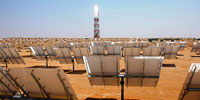 RIVERSIDE, Calif.—Pilots flying over the world’s largest solar power plant in the Mojave Desert have complained of nearly blinding glare from the sun’s reflection off its vast array of mirrors.
RIVERSIDE, Calif.—Pilots flying over the world’s largest solar power plant in the Mojave Desert have complained of nearly blinding glare from the sun’s reflection off its vast array of mirrors.
Two anonymous complaints were filed with the federal government in August, months before the Ivanpah Solar Electric Generating System formally opened across roughly 5 square miles of federal land near the California-Nevada border, the Riverside Press-Enterprise reported Friday ( http://bit.ly/1gomgrN).
A pilot wrote that it was impossible to look in the direction of the plant because of the intense brightness from the hundreds of thousands of mirrors. An air traffic controller reported receiving daily complaints about the brightness from pilots flying over the solar farm during the late morning and early afternoon.
Dozens of daily flights between Southern California and Las Vegas cross the area above or near the solar farm.
“I have no idea what can be done about this situation, but being a passenger on an aircraft that flew through this airspace and saw it for myself, I would say that something needs to be done. It is extremely bright and distracting,” the controller wrote.
NRG Energy Inc., a co-owner and operator of the plant, was investigating the issue and will respond within 10 days, company spokesman Jeff Holland said Friday.
He said developer BrightSource Energy was testing and calibrating the mirror assemblies, called heliostats, in August but it is unknown if that had anything to do with the reflection.
Using technology known as solar thermal, the computer-controlled mirrors roughly the size of a garage door track sunlight and reflect it onto boilers atop 459-foot towers. The sun’s power is used to heat water in the boilers’ tubes and make steam, which drives turbines to create electricity.
The risks of intense reflection from the solar arrays on aircraft and drivers on busy Interstate 15 were evaluated in the project’s environmental study. Pilots flying within 3,300 feet of the heliostats could experience temporary blindness and compromise safety, the study found.
To prevent possible problems, BrightSource was required to develop a heliostat positioning plan within 90 days of beginning operation to avoid potential hazards and to monitor brightness.
